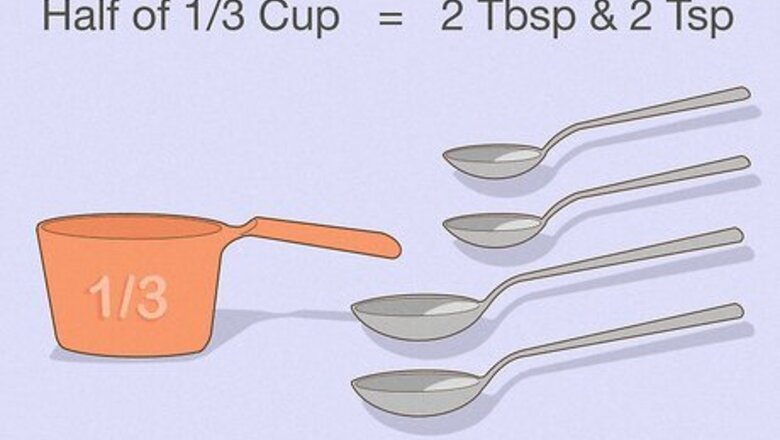
views
How to Halve ⅓ of a Cup
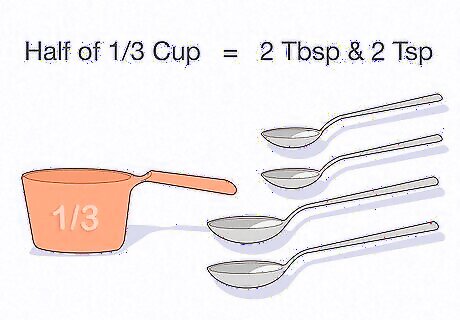
Half of ⅓ Cup is 2 tablespoons + 2 teaspoons. In order to find an accurate measurement of half of ⅓ cup, convert it to smaller units of measurement. Convert to tablespoons: there are 16 tablespoons (tbsps) in 1 cup, so divide 16 by 3 to get 5 ⅓ tbsps in ⅓ cup. Convert to teaspoons: There are 3 tsps in 1 tbsp, so multiply 5 by 3 to get 15 tsps. Because ⅓ of a tbsp is 1 tsp, add 1 to your total of 15 tsps for a total of 16 tsps in ⅓ cup. Divide in half: 16 tsps divided by 2 is 8 tsps in half of ⅓ cup. You can measure out 8 tsps or convert to tbsps. Because there are 3 tsps in a tbsp, divide 8 by 3 to get 2 tbsp with 2 tsps left over.
How to Halve Ingredients
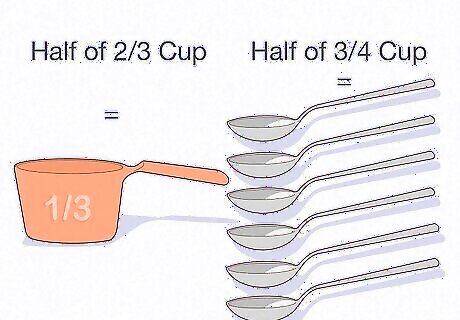
Halve each amount by dividing it by two. Here's a list of common common measurements halved: Half of 1 cup = 1/2 cup Half of 3/4 cup = 6 tbsp Half of 2/3 cup = 1/3 cup Half of 1/2 cup =1/4 cup Half of 1/3 cup = 2 tbsp + 2 tsp Half of 1/4 cup = 2 tbsp Half of 1 tbsp = 1-1/2 tsp Half of 1 tsp = 1/2 tsp Half of 1/2 tsp = 1/4 tsp Half of 1/4 tsp = 1/8 tsp
How to Divide Recipes into Thirds

Make ⅓ of a recipe by dividing each ingredient by 3. Here’s a list of common cooking and baking measurements divided into a third: One-third of 1 cup = 1/3 cup One-third of 3/4 cup = 1/4 cup One-third of 2/3 cup = 3 tbsp + 1-1/2 tsp One-third of 1/2 cup = 2 tbsp + 2 tsp One-third of 1/3 cup = 1 tbsp + 1-1/4 tsp One-third of 1/4 cup = 1 tbsp + 1 tsp One-third of 1 tbsp = 1 tsp One-third of 1 tsp = 1/3 tsp One-third of 1/2 tsp = 1/8 tsp One-third of 1/4 tsp = Dash
How to Convert to Tablespoons & Teaspoons

Make dividing ingredients easier by converting cups to tbsps and tsps. For easier division, convert measurements from cups to tbsps and tsps until you have a whole number. Here’s a list of common conversions for quick reference: 1tbsp = 3 tsp 1/8 cup = 2 tbsp 1/4 cup = 4 tbsp 1/3 cup = 5 tbsp + 1 tsp 1/2 cup = 8 tbsp 1 cup = 16 tbsp
How to Convert Recipes from Imperial to Metric

Convert liquid measurements from cups to milliliters (mL). Because milliliters are a smaller unit of measurement, they can also be easier to divide. Use the chart below to convert liquid measurements. 1/4 cup = 60 mL 1/3 cup = 70 mL 1/2 cup = 125 mL 2/3 cup = 150 mL 3/4 cup = 175 mL 1 cup = 250 mL 1 ½ cups = 375 mL 2 cups = 500 mL 4 cups = 1 liter

Convert dry ingredients from Imperial to Metric by weight. Imperial measurements of dry ingredients are most often by volume, while Metric measurements are by weight. That means a cup of flour has a different weight than a cup of granulated sugar. Use the following list to find the weight in grams of a cup of different common dry ingredients: 1 cup of all-purpose flour = 125g 1 cup of bread flour = 136g 1 cup of cocoa powder = 85g 1 cup of powdered sugar = 120g 1 cup of granulated sugar = 200g 1 cup of packed brown sugar = 220g
Small Measurement Equivalents in Recipes
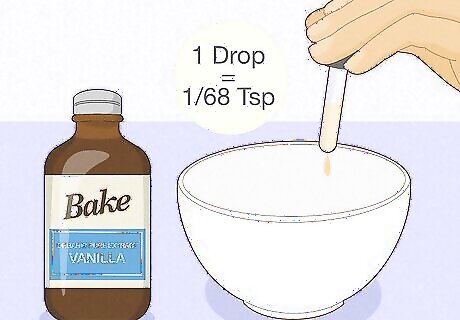
Recipes sometimes include small measurements that aren't precise. These are usually amounts smaller than common tools measure and are mostly found in vintage recipes. Because the amounts are so small, it may be less important to divide them with precision. Tad = 1/4 tsp Dash = 1/8 tsp Pinch = 1/16 tsp Smidgen or Shake = 1/32 tsp Drop or Nip = 1/64 tsp
How to Measure Ingredients Accurately
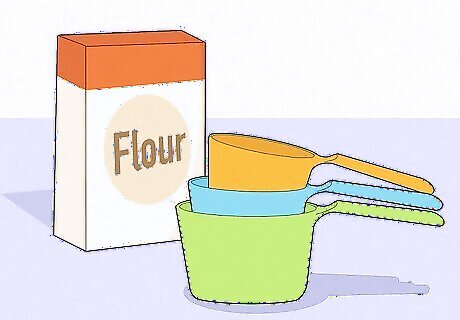
Use measuring cups and spoons for dry ingredients. Dry measuring cups and spoons are designed for dry ingredients, like sugar and flour.
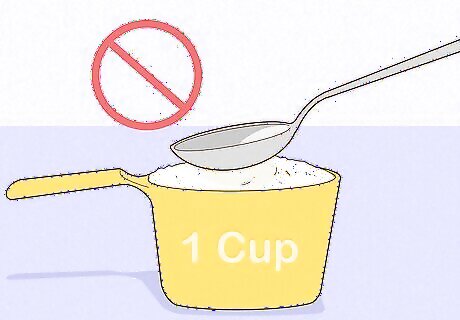
Don’t pack or press dry ingredients. When measuring dry ingredients, don’t use the measuring cup to scoop them from the container. This packs down ingredients like flour and sugar, which changes the measurement. Always spoon dry ingredients into the measuring cup, leaving a little extra mounded on the top. You can use a knife or spatula to level off the excess ingredients. Brown sugar is the exception to this rule. When spooning brown sugar, press on the sugar with the back of your scooping spoon until the measuring cup is full, and then level off.

Weigh dry ingredients with a kitchen scale as needed. Weighing dry ingredients with a digital kitchen scale is the most accurate way to divide a recipe. If you need to measure by weight, check the settings of your digital scale first. Digital scales can usually be set to grams or ounces. Make sure the setting matches the unit of measurement in your recipe. Zero out your digital scale after placing a bowl on it for easier measuring. Make sure you aren’t confusing ounces with fluid ounces.
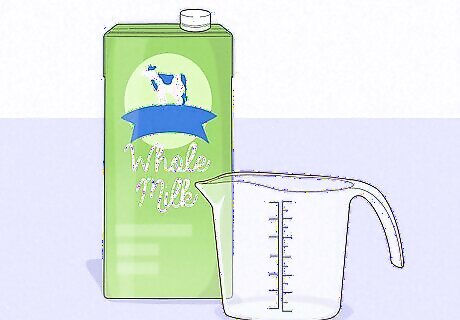
Use liquid measuring cups for liquids. Always measure liquids on a flat surface at eye level. Place your measuring cup on a flat, level surface like a countertop to measure liquids. Once you have poured the liquid into the measuring cup, bend or kneel so your eyes are even with the surface level of the liquid to take a more accurate measurement.

Coat your measuring cup or spoon with oil to measure sticky ingredients. When measuring sticky ingredients, like honey or maple syrup, they tend to stick to the measuring tool throwing off the amount that makes it into your mixing bowl. Coat your measuring cup with a very small amount of oil or a spritz of cooking spray. The oil or cooking spray will prevent the ingredient from sticking, helping it to slide right out.

Halve an egg by cracking it open. Sometimes you want to divide a recipe that only calls for one raw egg. Crack the egg into the bowl and throw away the shell. Once you have the contents of the egg, it's easier to eyeball or weigh. If using the whole egg, whisk it to combine the white and yolk. Either eyeball half of the whisked egg or weigh it on a scale and then remove a little of the egg mixture at a time until you have half of the original amount. If you only need part of the egg, separate the yolk from the white. Then, divide only the part of the egg you need for your recipe.
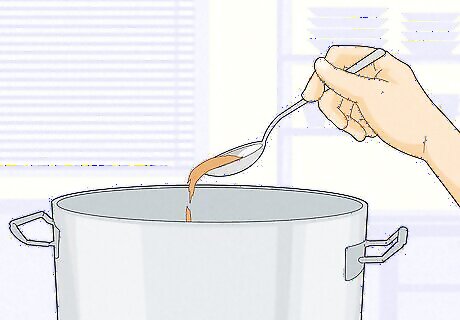
Visually estimate or eyeball measurements as needed. This is the least accurate way to divide a recipe, but it can work in some situations. However, it's not recommended for baking, which requires more precise measurements for the proper consistency.











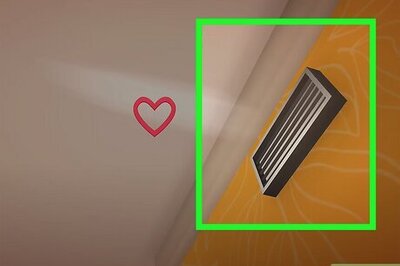
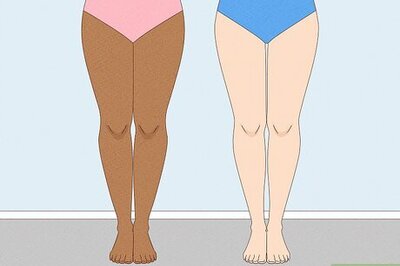





Comments
0 comment